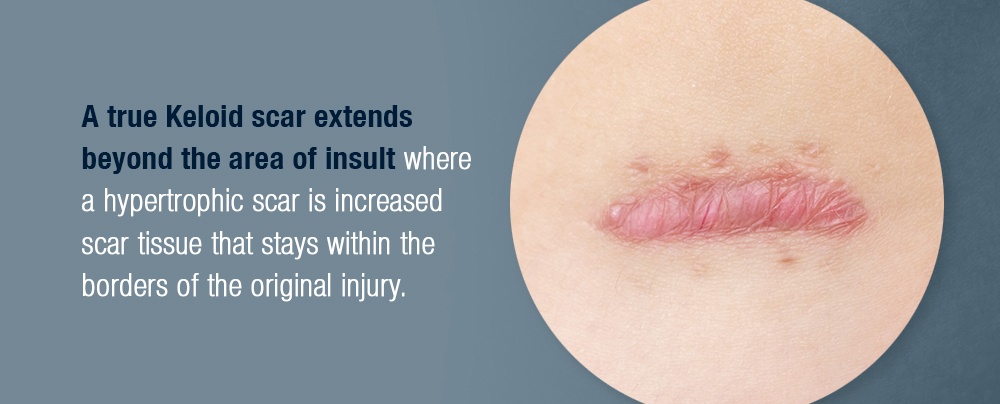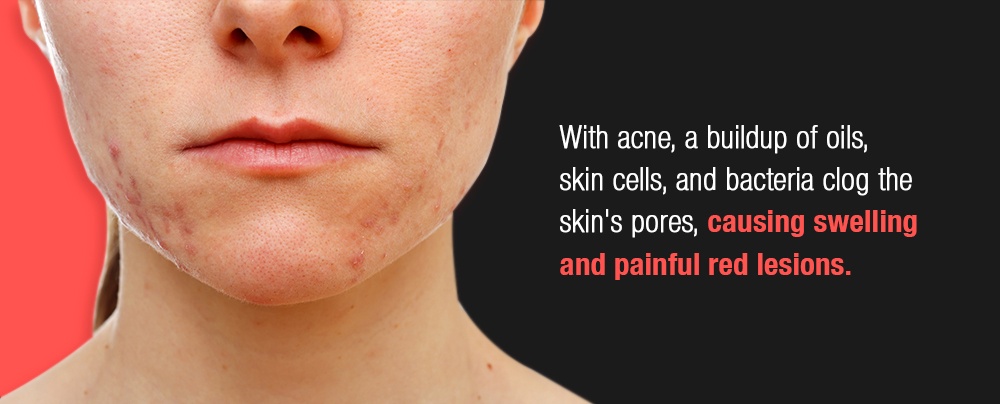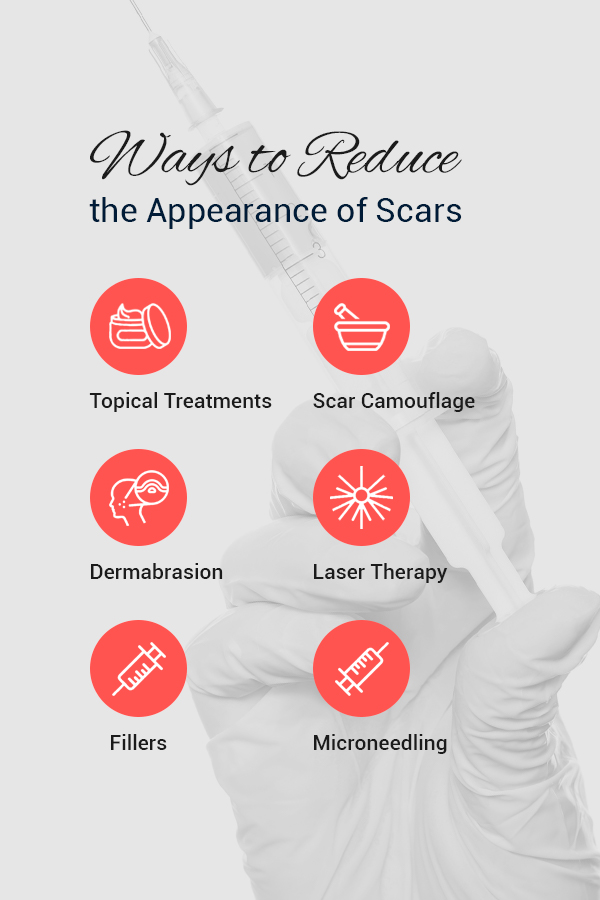Do Scars Ever Go Away Completely?
Scars are reminders of past injuries, surgeries, or other traumatic experiences, and often we just want them to go away completely. But because scar tissue is different from the surrounding tissues, it is generally permanent. There are many different types of scars, and each one may heal in a different way from other scars. If scars are bothering you, the good news is that there are many ways to minimize scarring.
Schedule A Scar Treatment Consultation Today
Where Do Scars Come From?
Any time the skin is injured, scars can appear as part of the body’s natural healing processes. Skin injuries can come from accidents, surgeries, certain diseases, and skin conditions like acne and psoriasis. Some more minor injuries may not result in scarring, but almost all injuries that damage the dermis — the deep, thick layer of skin — will produce a scar.
When the dermis is injured, the body begins to repair itself by producing more collagen fibers in the damaged area. These collagen fibers serve to repair the wound, closing it off, and forming new scar tissue when the wound has healed completely. The new tissue generally has a different texture and appearance than the surrounding skin and can be flat and pale, a darker color, or have a raised or sunken appearance.
There are three main stages to wound healing and scar development:
- Inflammatory stage: The body responds to the injury, forming a blood clot to stop the bleeding. White blood cells rush to the area to begin healing. During this stage, the surrounding skin may be reddened, and feel hot and painful.
- Proliferation stage: During this next stage, collagen fiber production starts to repair the wound, giving strength and structure to the area. The epidermis at the top layer of the skin starts to close off the wound, pulling it together and making the wound appear smaller.
- Maturation stage: This final stage of the healing process can last anywhere from several weeks to several years to complete fully. The initial collagen fibers are replaced with a stronger form of collagen as the wound is permanently sealed.
Scars may be darker at first and fade to a lighter color over time as part of the scar maturation process. Mature scars can also flatten out as they go through this aging process, but it’s important to note that scars will never go away completely. Even with some scar treatments, the appearance will be improved, but they will never totally disappear because the skin composition is different from the surrounding tissues.
Types of Scars That People Get
Scar tissue forms from all sorts of accidental injuries, surgical procedures, or diseases or skin issues. The type of injury, as well as its severity and the location on the body where the injury occurred, will all affect the appearance of the scar. Other factors can also influence how the scar looks, including a person’s age, sex, ethnicity, and genes.
There are many different types of scars, and each type of scar may look, feel, and heal differently. These can include the following categories:
Keloid Scars
Some types of scars heal in a way in which the scar appears raised off of the skin — this is called a keloid scar. These raised scars are caused by overactive healing processes and excessive collagen production when the scar is forming. In fact, long after the wound has healed, this type of scar continues to form more tissue, causing a growth above the skin. Some keloids continue to grow months or years after the original injury heals. A true Keloid scar extends beyond the area of insult where a hypertrophic scar is increased scar tissue that stays within the borders of the original injury. Scientists aren’t sure why some scars develop in this way.
Keloids can occur from any type of skin injury including cuts, burns, puncture wounds, surgical incisions, acne, tattoos, piercings, and more. But some people are more likely to develop a keloid. The risk of keloid development is increased for:
- Teenagers during puberty
- Those who are pregnant
- Anyone with darker skin
- Those with a family history of keloids
These scars can develop on any area of the body but are most commonly found on the neck, back, chest, shoulders, and ears. They are often pink, red, or purple and may darken over time. They can feel softer than the surrounding skin, or hardened and rubbery. While growing, the keloid may feel tender, itchy, or painful. The growths are harmless, but many people are bothered by their appearance. Treatments can reduce the appearance of keloids, but will not likely make them disappear. Surgical removal carries a risk of the keloid reappearing.

Hypertrophic Scars
Similar to a keloid scar, hypertrophic scars are the result of abnormal healing processes where the scar tissue appears as wide, thick, and raised from the surface of the skin. Hypertrophic scars are generally milder than keloids, as they do not grow beyond the borders of the original injury. These raised scars occur from an overproduction of collagen during the healing process. Certain people are more naturally inclined to get hypertrophic scars, or they can result from complications like infection or inflammation of a wound.
Although hypertrophic scars can occur anywhere on the body, when the wound occurs over a joint, where the injury is subject to tension and motion, it’s more likely to develop a hypertrophic scar. These scars are also more commonly found in those with darker skin, and with burn injuries or piercings, cuts, acne, and deeper wounds that did not receive stitches. Hypertrophic scars are generally red or pink in color and aren’t dangerous on their own. Many people are bothered by the appearance of these scars and seek treatment to reduce their appearance. Corticosteroid treatments, cryotherapy, and surgical removal are some of the most common treatments for hypertrophic scars, but a wide variety of therapies can be used to reduce their appearance.
Contracture Scars
Contracture scars are a special type of scar that occurs as a complication of a healing burn injury. As a burn heals, a contracture scar matures, thickening and tightening the skin, and pulling at the surrounding skin. This can be a serious complication of the burn, especially when they form around or near a joint, as they can limit the range of motion of the joint. More severe contracture scars can affect deeper layers of tissue, damaging muscles and nerves.
Contracture scars can occur anywhere on the body and often appear as flat, shiny patches of skin. For the most severe skin contractures, reconstructive surgery and skin grafts are often recommended. For more mild forms of contracture scars, treatments like physical therapy, compression garments, and applying raw honey and vitamin E oil as the burn is healing can all help. Other treatments can help to reduce the appearance of these scars as well.
Acne Scars
Acne is a common skin condition for teens, but it can affect any age group. With acne, a buildup of oils, skin cells, and bacteria clog the skin’s pores, causing swelling and painful red lesions. Sometimes the lesions are small and can heal quickly, but other times, a deeper break in the wall of the pore causes the infected material to spread to surrounding tissues, making larger lesions on the skin. New collagen fibers form in the lesion as the skin attempts to repair itself, but the result is often a different texture than the surrounding skin, making long-lasting scars.
Severe acne generally results in two main types of scarring:
- Hypertrophic scars and keloids: When the skin produces too much collagen during healing, it can result in hypertrophic scars or keloids. These types of scars are raised above the surface of the skin.
- Atrophic or depressed scars: Alternatively, acne can also cause scars that look more like holes or dents in the skin. These scars occur from a loss of tissue and can look like tiny holes in the skin, or rounded, depressed areas of scar tissue.
Anyone can have scarring from acne, and these scars occur most often on the face, but can also be found on other areas like the neck, back, chest, and shoulders. Many different surgical and non-surgical options are available for treating acne scars. The best options for each individual depend on the type of acne scars that they have.
Ways to Reduce the Appearance of Scars
Most scars are not dangerous and are usually not painful once they are healed. But for many people, scars can cause a lack of self-confidence, and finding treatments that reduce the appearance of scars can help them feel more youthful, beautiful, and confident in their looks. From home remedies to plastic surgery, many different treatments can help reduce scarring and create a more natural look. Here are some of the best treatments to make a scar fade:
Topical Treatments
There are several different types of creams, oils, and other topicals that may reduce the appearance of some minor scars. However, most of these types of treatments may only make a subtle difference. For larger or more serious scars, other types of treatments may be necessary.
The main categories of topical scar treatments include:
- Home remedies: Vitamin E oil, raw honey, cocoa butter, and vitamin K, among others, are all recommended, but little research has been done on the efficacy of these products for scars. However, Dr. Brought is a strong proponent of moisturizer to keep the tissue soft and supple to avoid dryness and cracking. In addition, he emphasizes the importance of massaging healed scars to prevent and breakdown developing scar tissue. The timing of such modalities is important so always be sure to follow specific instructions in regards to when to initiate the various types of scar therapy.
- Over-the-counter treatments: Your local pharmacy will have a variety of over-the-counter creams containing ingredients like onion extract and allantoin. Silicone gel sheets are another over-the-counter option for scar treatments and there is scientific evidence to support their use in treating scars, although they typically require strict compliance for a period of at least 12 weeks.
- Prescription treatments: Doctors can prescribe topical creams containing retinol or steroids to treat scar tissue.
Scar Camouflage
A unique medical process that works similarly to tattooing, scar camouflage infuses the scarred skin with color that matches the surrounding skin, thus camouflaging the scar. After this easy procedure, scars are barely noticeable. Scar camouflage procedures are best for scars that are thin and from small cuts or incisions.
Scar camouflage is especially helpful for small scars on the face and can give a more youthful, even look to the skin. The treatment is non-surgical and requires very little recovery time. Scars on the face can make wrinkles, fine lines, and creases more noticeable and makeup applications look uneven. But with scar camouflage treatment, makeup goes on more evenly and confidence is improved with an overall even, natural look.
The pigments used in scar camouflage are not as long-lasting as the inks used in tattoos, and touch-ups may be necessary over time. But our skin also naturally has slight changes in tone and color as we age, so subsequent touch-ups can match the current skin tone even more exactly, helping scars to remain hidden even with the natural signs of aging.
Dermabrasion
Originally developed as a scar treatment, dermabrasion is now used for a variety of skin issues. This procedure is done in a dermatologist’s or plastic surgeon’s office and works by “sanding” the top layer of skin, to reveal the fresh, smooth, youthful skin underneath. The clinician uses a high-powered instrument with an abrasive wheel or brush to remove the outermost layer of skin, improving the skin’s tone and texture and removing irregularities on the skin’s surface.
Dermabrasion procedures are best for acne scars and other small scars and are not recommended for burns and other larger-scale scars. For anyone with darker skin, dermabrasion can result in discoloration and further scarring, so it is generally only used for people with fair skin. However, microdermabrasion is a much gentler version of the treatment and can be used on any skin color and type, although the effects will be more subtle.
After dermabrasion, the skin may look red or pink and feel tender and burned for a few days. The skin should fully heal after seven to 10 days, and develop its normal color soon after.
Laser Therapy
Lasers can also be used to treat scar tissue, and this therapy works similarly to dermabrasion procedures. In a laser scar treatment, a dermatologist or plastic surgeon uses a laser wand on the affected area to target specific cells needing treatment and leaving healthy cells untouched. The lasers use heat and light to remove the outermost layer of damaged skin, revealing the healthier skin underneath and making scar tissue less noticeable. Laser therapy also penetrates deeper layers of skin, stimulating new cell growth.
Recovery time for laser therapy ranges from about three to 10 days and patients may experience mild pain and swelling at the treatment site. After healing, the scars will be diminished and results are long-lasting, although touch-up treatments may be necessary later on.
Fillers
For any scars that have formed as depressions or pits in the skin, such as with many acne scars, soft-tissue fillers can be used to plump up scars to match the surrounding skin. Several types of fillers are available, and your doctor can help you decide which one is best for you. Most fillers contain either hyaluronic acid or a collagen-stimulating agent. The fillers are injected into the skin using a fine needle in an easy, outpatient procedure.
After treatment using fillers, mild bruising, swelling, and redness at the injection site are common but should diminish after a few days. The treatment is temporary, and depending on the type and severity of the scars, ongoing maintenance treatments may be necessary. With treatments, scars are filled in and the skin looks much smoother.
Microneedling
Just as it sounds, microneedling procedures use several small needles to prick the skin and stimulate the production of healing collagen. This new collagen that forms helps to smooth out the skin and give it a more radiant appearance. The treatment can be used to fill in fine lines and wrinkles, as well as improve the appearance of all types of scars. As cosmetic surgery for scars, microneedling is great for burn scars, acne scars, scars from surgical incisions, stretch marks, and more. The treatments may be best for depressed, not raised, scars, but your doctor can help you decide.
Redness, inflammation, and minor bruising are common after a microneedling procedure, but symptoms should clear in a few days. The treatments are quick and easy and result in much smoother skin.
Plastic Surgery for Scars
If scars are affecting your appearance and confidence, check out your options for how to heal scars with treatments at the Southern Plastic & Reconstructive Surgical Institute. We offer a wide range of products and services designed to make you look and feel your best, all with a holistic approach. Dr. Brought and his caring staff will help you find the best scar removal treatment for you. Contact us today to schedule your consultation and get started on minimizing your scars.




